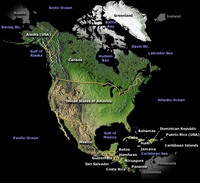Login form
North America
 North America was long known as the New World by the people of Europe. Of course, North America was only “new” to the Europeans. Native Americans had lived there for thousands of years before Europeans arrived.
North America was long known as the New World by the people of Europe. Of course, North America was only “new” to the Europeans. Native Americans had lived there for thousands of years before Europeans arrived.
Colonists from England, France, and Spain flocked to North America after Christopher Columbus’s famous voyage in 1492. They claimed land and wealth for themselves and their kings. These countries gradually lost their lands in North America. But their influence still shows in the people and cultures of North America.
THIRD LARGEST CONTINENT
North America is the third largest of the world’s seven continents. Only Asia and Africa are larger. Canada, the United States, and Mexico cover most of the continent.
Central America and the islands of the Caribbean Sea are usually considered a part of the continent. Greenland, the world’s largest island, is considered part of North America, too.
WHY IS IT CALLED NORTH AMERICA?
The name America comes from an Italian navigator named Amerigo Vespucci. America is a version of Amerigo’s name. Vespucci explored part of South America in the late 1490s. He may also have reached the mainland of North America.
Mapmakers first applied the name America to the southern continent, or South America, in honor of Vespucci. But they soon started using it for the northern continent as well.
EVERY KIND OF CLIMATE
You can find every kind of climate in North America. Ice-covered plains cover the far north. Central America and the Caribbean Islands have warm tropical weather. Heavy rains water the northwest coast of North America. Dry lands and desert cover much of northern Mexico and the American West.
EASTERN NORTH AMERICA
A long plain stretches along the coast of most of eastern North America. The Appalachians, a chain of rounded mountains, run along much of this plain. The Appalachians reach from Québec in Canada all the way to Alabama. Many rivers cut through these thickly forested mountains.
THE MOUNTAINOUS WEST
Western North America is mountainous and rugged. Here stand the great Rocky Mountains, which stretch from Alaska to Mexico. The Sierra Madre ranges rise in Mexico.
Coastal mountain chains tower above much of North America’s west coast, too. Between the coastal ranges and the Rocky Mountains is a huge drainage area called the Great Basin. Here lie a number of ancient salty lakes, including the famous Great Salt Lake of Utah.
CONTINENTAL DIVIDE
Parts of the Rocky Mountains and Sierra Madre make up the Continental Divide. On one side of this great divide, all rivers flow west, to the Pacific Ocean. On the other side, the rivers flow east.
THE GREAT PLAINS
In central North America, between the Rocky Mountains and the Appalachians, is a vast open area called the Great Plains. Most of the area is a treeless grassland. Millions of buffalo once roamed the Great Plains. Today, wheat fields cover much of the plains. Great herds of cattle feed on its grasses.
THE CANADIAN SHIELD
In the northeast and north central part of the continent is the Canadian Shield. It’s a huge, flat region of thin soil lying on very hard rock.
The Canadian Shield is the biggest part of Canada. The area is so rocky that Canada had great difficulty building a railroad over it. Farming the land isn’t easy either, and few people live there.
BIG WATERS
North America is a land of big waters. A number of great rivers drain the continent. The Mississippi, which flows from north to south in the central United States, is the continent’s most important river. The Missouri is North America’s longest river. From the western United States, it runs nearly 2,540 miles (4,090 kilometers) before reaching the Mississippi. Other mighty rivers include the Colorado, Columbia, Yukon, Mackenzie, Fraser, and St. Lawrence.
North America has three great inlets around its shores. The Gulf of Mexico is in the south. The Gulf of Alaska is in the northwest. Hudson Bay is in the far north.
Near the center of the continent are the five Great Lakes. One of them, Lake Superior, is the largest freshwater lake in the world.
A LAND OF IMMIGRANTS
Today, North America is home to over 509 million people. It’s the world’s fourth most populated continent. It is also home to three of the world’s largest cities: Mexico City, New York, and Los Angeles.
Native Americans still inhabit the continent, from the Inuit in the frozen Arctic to the Maya of southern Mexico and Central America. But most people in North America have origins elsewhere. Millions of immigrants from all over the world have come to North America seeking better lives.
The largest group of people in the United States and Canada came from the British Isles. They make up about one-third of the population. About one-quarter of Canadians have French ancestors. In Mexico, most people are mestizos, persons of mixed Native American and European descent. Most mestizos have ancestors from Spain.
Source: Microsoft ® Encarta

